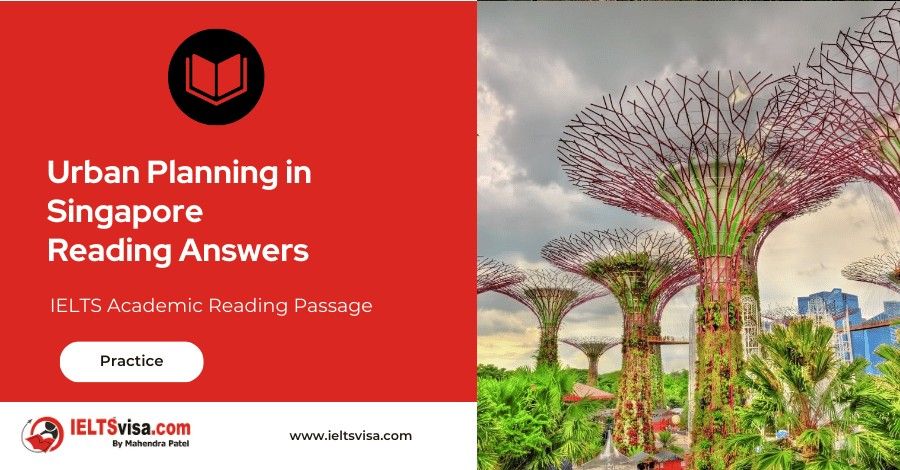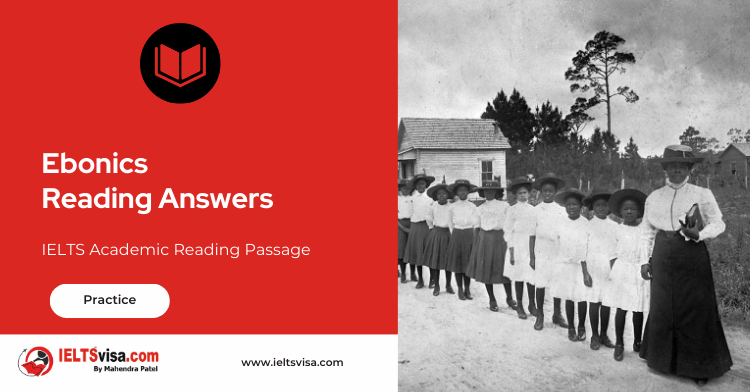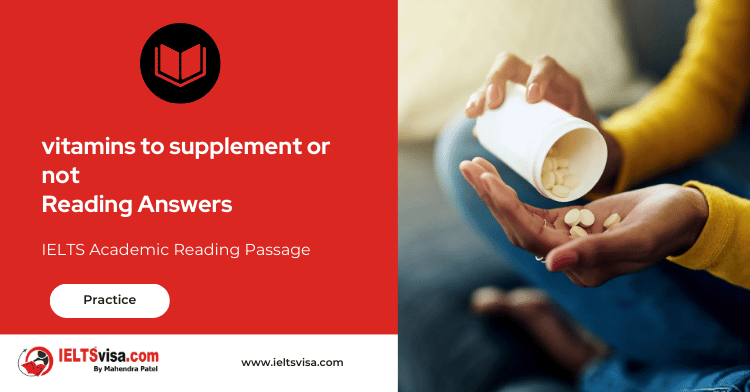Urban Planning in Singapore Reading Answers
IELTS Academic Reading Passage
A. British merchants established a trading post in Singapore in the early nineteenth century, and for more than a century trading interests dominated. However, in 1965 the newly independent island state was cut off from its hinterland, and so it set about pursuing a survival strategy. The good international communications it already enjoyed provided a useful base, but it was decided that if Singapore was to secure its economic future, it must develop its industry. To this end, new institutional structures were needed to facilitate, develop, and control foreign investment. One of the most important of these was the Economic Development Board (EDB), an arm of government that developed strategies for attracting investment. Thus from the outset, the Singaporean government was involved in city promotion.
B. Towards the end of the twentieth century, the government realised that, due to limits on both the size of the country’s workforce and its land area, its labour-intensive industries were becoming increasingly uncompetitive. So an economic committee was established which concluded that Singapore should focus on developing as a service centre, and seek to attract company headquarters to serve South East Asia, and develop tourism, banking, and offshore activities. The land required for this service-sector orientation had been acquired in the early 1970s when the government realised that it lacked the banking infrastructure for a modern economy. So a new banking and corporate district, known as the ‘Golden Shoe’, was planned, incorporating the historic commercial area. This district now houses all the major companies and various government financial agencies.
C. Singapore’s current economic strategy is closely linked to land use and development planning. Although it is already a major city, the current development plan seeks to ensure Singapore’s continued economic growth through restructuring, to ensure that the facilities needed by future business are planned now. These include transport and telecommunication infrastructure, land, and environmental quality. A major concern is to avoid congestion in the central area, and so the latest plan deviates from previous plans by having a strong decentralisation policy. The plan makes provision for four major regional centres, each serving 800,000 people, but this does not mean that the existing central business district will not also grow. A major extension planned around Marina Bay draws on examples of other ‘world cities’, especially those with waterside central areas such as Sydney and San Francisco. The project involves major land reclamation of 667 hectares in total. Part of this has already been developed as a conference and exhibition zone, and the rest will be used for other facilities. However the need for vitality has been recognised and a mixed zoning approach has been adopted, to include housing and entertainment.
D. One of the new features of the current plan is a broader conception of what contributes to economic success. It encompasses high-quality residential provision, a good environment, leisure facilities and exciting city life. Thus there is more provision for low-density housing, often in waterfront communities linked to beaches and recreational facilities. However, the lower housing densities will put considerable pressure on the very limited land available for development, and this creates problems for another of the plan’s aims, which is to stress environmental quality. More and more of the remaining open area will be developed, and the only natural landscape surviving will be a small zone in the centre of the island which serves as a water catchment area. Environmental policy is therefore very much concerned with making the built environment more green by introducing more plants – what is referred to as the ‘beautification’ of Singapore. The plan focuses on green zones defining the boundaries of settlements, and running along transport corridors. The incidental green provision within housing areas is also given considerable attention.
E. Much of the environmental provision, for example, golf courses, recreation areas, and beaches, is linked to the prime objective of attracting business. The plan places much emphasis on good leisure provision and the need to exploit Singapore’s island setting. One way of doing this is through further land reclamation, to create a whole new island devoted to leisure and luxury housing which will stretch from the central area to the airport. A current concern also appears to be how to use the planning system to create opportunities for greater spontaneity: planners have recently given much attention to the concept of the 24-hour city and the cafe society. For example, a promotion has taken place along the Singapore river to create a cafe zone. This has included the realisation, rather late in the day, of the value of retaining older buildings, and the creation of a continuous riverside promenade. Since the relaxation in 1996 of strict guidelines on outdoor eating areas, this has become an extremely popular area in the evenings. Also, in 1998 the Urban Redevelopment Authority created a new entertainment area in the centre of the city which they are promoting as ‘the city’s one-stop, dynamic entertainment scene’.
F. In conclusion, the economic development of Singapore has been very consciously centrally planned, and the latest strategy is very clearly oriented to establishing Singapore as a leading ‘world city’. It is well placed to succeed, for a variety of reasons. It can draw upon its historic roots as a world trading centre; it has invested heavily in telecommunications and air transport infrastructure; it is well located in relation to other Asian economies; it has developed a safe and clean environment; and it has utilised the international language of English.
Question 01-06
Complete the summary below using words from the box.
|
Decentralisation |
Fuel |
Industry |
|
Industry |
Hospitals |
Loans |
|
Deregulation |
Service |
Trade |
|
Transport |
Entertainment |
Recycling |
|
Labour |
Tourism |
Hygiene |
|
Beautification |
Agriculture |
– |
Singapore
When Singapore became an independent, self-sufficient state it decided to build up it’s (1) ……………, and government organisations were created to support this policy. However, this initial plan was met with limited success due to a shortage of (2) ……………….. and land. It was therefore decided to develop the (3) ……………….. sector of the economy instead.
Singapore is now a leading city, but planners are working to ensure that its economy continues to grow. In contrast to previous policies, there is an emphasis on (4) ……………….. . In addition, the land will be recovered to extend the financial district, and provide (5) ……………….. as well as housing. The government also plans to improve the quality of Singapore’s environment, but due to the shortage of natural landscapes, it will concentrate instead on what it calls (6) …………………
Question 07-13
Do the following statements agree with the information given in the Reading Passage? Write:
- True (if the statement agrees with the information)
- False (if the statement contradicts the information)
- Not Given (if there is no information on this)
7. After 1965, the Singaporean government switched the focus of the island’s economy.
8. The creation of Singapore’s financial centre was delayed while a suitable site was found.
9. Singapore’s four regional centres will eventually be the same size as its central business district.
10. Planners have modelled new urban developments in other coastal cities.
11. Plants and trees are amongst the current priorities for Singapore’s city planners.
12. The government has enacted new laws to protect Singapore’s old buildings.
13. Singapore will find it difficult to compete with leading cities in other parts of the world.

Solution For: Urban Planning in Singapore
Reading Answers
| 1. Industry | 8. False |
| 2. Labour | 9. Not Given |
| 3. Service | 10. True |
| 4. Decentralisation | 11. True |
| 5. Entertainment | 12. Not Given |
| 6. Beautification | 13. False |
| 7. True |
Review and Practice
- Regularly practice with IELTS reading samples and time yourself to get used to the pressure of the exam.
- Review your mistakes to understand where you went wrong and how to avoid similar errors in the future.
Our Books
Master IELTS Speaking Part 1
IELTS Writing Task 1 Book
IELTS Writing Task 2 Book
Urban Planning in Singapore Reading Answers Explanation
Comin Soon
Practice IELTS Other Modules
IELTS Listening
The IELTS Listening test assesses how well you can understand spoken English in various contexts. It lasts about 30 minutes and is divided into four sections with a total of 40 questions. The listening tasks become increasingly difficult as the test progresses.
IELTS Academic Reading
The IELTS Academic Reading section assesses your ability to understand and interpret a variety of texts in academic settings. It is designed to evaluate a range of reading skills, including skimming for gist, reading for main ideas, reading for detail, understanding inferences, and recognizing a writer's opinions and arguments.
IELTS Speaking
The IELTS Speaking test assesses your ability to communicate in English on everyday topics. It lasts 11-14 minutes and consists of three parts: introduction, cue card, and a discussion based on the cue card topic.
IELTS General Reading
IELTS General Reading tests your ability to understand and interpret various types of texts. Here are some key areas and types of content you can expect to encounter in the reading section, along with tips for effective preparation.
IELTS Academic Writing Task 1
In IELTS Academic Writing Task 1, you are presented with a visual representation of information, such as graphs, charts, tables, or diagrams, and you are required to summarize, compare, or explain the data in your own words.
IELTS General Writing Task 1
In IELTS General Writing Task 1, you are required to write a letter based on a given situation. The letter can be formal, semi-formal, or informal, depending on the prompt. Here’s a breakdown of the key components to include in your letter
IELTS Academic Writing Task 2
In IELTS Academic Writing Task 2, you are required to write an essay in response to a question or topic. Here’s a guide to help you understand the essential elements of this task
IELTS Exam Tips
To succeed in the IELTS exam, practice regularly, familiarize yourself with the test format, improve your vocabulary, develop time management skills, and take mock tests to build confidence.
Grammer for IELTS
Grammar is the foundation of effective communication in English. Understanding tense usage, subject-verb agreement, and sentence structure enhances clarity and coherence in writing and speaking.
Vocabulary for IELTS
Vocabulary plays a crucial role in the IELTS (International English Language Testing System) exam, especially in the Speaking and Writing sections. Here’s an overview of why vocabulary is important and how it impacts your performance
RECENT IELTS SAMPLES QUESTIONS AND ANSWERS
Ebonics Reading Answers
A. Ebonics - also known by a host of other names such as African American Vernacular English,...
A Disaster Of Titanic Proportions
A. At 11:39 p.m. on the evening of Sunday, 14 April 1912, lookouts Frederick Fleet and...
Vitamins To supplement or not?
Mineral, vitamin, and antioxidant health supplements make up a multi-billion-dollar industry...
The Hollywood film industry
A. This chapter examines the ‘Golden Age’ of the Hollywood film studio system and explores how...
Three Dimensional Films Reading Answers
A. In the theatre of the Ambassador Hotel in Los Angeles, on the evening of 27 September 1922,...
The Developing World Reading Answers
A THE DEVELOPING WORLD — the economically underdeveloped countries of Asia. Africa. Oceania...













